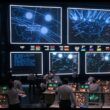Missiles: The hidden force behind nuclear proliferation
By Masako Ikegami, June 29, 2016
In January, North Korea conducted its fourth nuclear test—detonating its "first hydrogen bomb," or so Pyongyang claimed. Since then, the North has conducted a series of missile tests, the latest a June 22 launch into high altitude of an intermediate-range ballistic missile (the Hwasong-10 or, as it's known to the outside world, the Musudan). This test, after five launch failures in a row, was "successful." North Korea's missile program is advancing steadily—and Pyongyang is miniaturizing nuclear warheads successfully enough to mount them on various ballistic missiles with Musudan-type engines. This skill can be applied to the country's first intercontinental ballistic missile, the KN-08, currently under development.
Immediately after the June 22 test, the UN Security Council strongly condemned North Korea's ballistic missile launches. It was the fifth such condemnation this year. The Security Council noted that "these repeated acts are in grave violation of obligations under the relevant resolutions" and that "these activities contribute to the development of the country's nuclear weapons delivery systems and increase tension." Since 2006 the Security Council has adopted five major resolutions imposing or strengthening sanctions on North Korea because of its nuclear weapons program. The United Nations has also issued numerous condemnations of North Korea's missile, "rocket," or "satellite" launches.
The international community's harsh, persistent criticism of North Korea's missile and rocket launches highlights the basic reality that missiles are integral parts of nuclear weapons. But oddly, only North Korea's missile tests are subject to such harsh condemnation. Tests conducted by other countries, even Iran, do not draw so much attention. To be sure, North Korea's nuclear weapons program makes Pyongyang's missile development seem more threatening. But missiles are a critical component of all countries' nuclear weapons—so missile proliferation deserves as much concern, and the same efforts at prevention, as nuclear proliferation deserves.
Major nuclear powers such as the United States, Russia, and China constantly conduct missile tests to expand their offensive capabilities. In so doing they provoke a sense of insecurity among other states. Arguably, the major powers' advanced and precisely guided missiles only provide an incentive for other nations to develop nuclear weapons; nuclear weapons, meanwhile, drive the development of advanced missiles. The two together maximize a nation's potential to effect destruction, thereby—many believe—making deterrence more credible. Then again, missiles armed with conventional warheads can be regarded as a substitute for nuclear weapons. South Korea, for example, has invested great resources in developing ballistic and cruise missiles with ever longer ranges, apparently in an effort to counter or compete with North Korea's nuclear weapons program. In any event, the missile proliferation agenda shouldn't confine itself narrowly to controversial cases such as North Korea's missile program or China's missile trade with the Middle East.
Unfortunately, institutional and legal arrangements for reining in the missile trade are inadequate and in danger of losing their relevance. The Missile Technology Control Regime was established in 1987 as a voluntary mechanism to limit the spread of ballistic missiles and other unmanned delivery systems that could be used for attacks using weapons of mass destruction. The regime's 35 members include most of the world's key missile manufacturers, and members are expected to restrict their exports of missiles (and related technologies) capable of delivering a 500-kilogram payload at least 300 kilometers, or of delivering any type of WMD. While the regime is credited with having slowed or halted several missile programs, it has some weaknesses. The regime involves no commitment to restrain existing missile arsenals or to achieve missile disarmament. It entails "no international monitoring or verification measures to detect and forestall interstate transfers" of missile technology and production. Its export controls on dual-use goods are strict and rigid. This stands in the way of civilian technology cooperation and undermines the economic interests of suppliers and recipients alike. And as the regime is non-binding, its implementation tends to be arbitrary—the United States and South Korea, for example, reached a deal in 2012 extending the maximum allowable range of Seoul's ballistic missiles from 300 kilometers to 800, and their maximum payload from 500 kilograms to as much as 1.5 metric tons, far exceeding limits specified under the regime. Arbitrary enforcement undermines the regime's legitimacy—and the regime's salience seems to be fading, with missile proliferation nowadays receiving scant attention compared to security concerns such as nuclear security and terrorism.
As the regime is rendered impotent, the result will be less effective control of dual-use technologies applicable to missiles—modern missiles, after all, contain various advanced technologies that also appear in space applications and elsewhere. Effective control over these technologies won't likely be exerted by complementary regulatory structures such as the Nuclear Suppliers Group or the Wassenaar Arrangement. The government of Japanese Prime Minister Shinzo Abe did little to remedy the problem when in April 2014 it set aside the "Three Principles," a ban on exports of weapons, military hardware, and technology in place since 1967. As I have discussed elsewhere, Japan was already a major supplier of advanced civilian dual-use technologies with possible military applications even when the Three Principles remained in force. Japan's participation in the global arms business as a supplier of advanced military technologies and components will only exacerbate the missile proliferation problem.
Nuclear weapons consist of nuclear warheads and delivery systems. The two are inseparable. This fundamental fact, whether intentionally or unintentionally, is often left out of the discourse on nuclear disarmament. Nuclear nonproliferation efforts that neglect missile proliferation are bound to be unproductive—indeed, missile proliferation is the hidden, driving force behind nuclear proliferation. If the world is ever to be free of nuclear weapons, it is time to start addressing missile nonproliferation and nuclear disarmament as two inseparable elements of the same agenda.
Topics: Nuclear Weapons, Technology and Security
Share: [addthis tool="addthis_inline_share_toolbox"]














